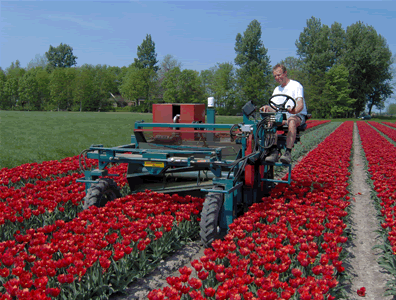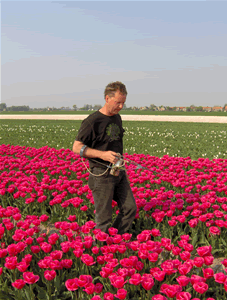Tulip forcing.
Index
The cultivation of tulips in Holland.
The growing-cycle of the tulip.
Tulip forcing.
Forcing on farm ground.
Wet-cooling (9oC).
Dry-cooling (5oC).
Water-forcing.
Examples.
The cultivation of tulips in Holland.(top)
Most of the tulip bulbs sold around the world are grown in Holland. These bulbs are the result of many years of tulip bulb production. Every year tulips are grown in Holland to gain more bulbs to sell. Almost every bulb planted for production, grows a tulip and develops several new bulbs depending on the species.
In Holland the tulip bulbs are planted from half October till half December depending on the weather conditions. The tulip growers start planting the tulip bulbs when the soil temperature has gone down to +/- 12oC. When the soil temperature is higher there is a risk for diseases like Augusta sick and Fusarium.
After the bulbs are planted, they start rooting in the soil. From November till February the tulips stay below the surface because the temperature is low during this period (-10oC/ 5oC). This period of low temperature is necessary for the tulips to get their length later on.
When around the end of March the temperature starts rising in Holland, the tulips start growing out of the ground. When the leafs of the tulip plants start spreading, the tulip growers start selecting the tulip plants for viruses by looking for differentials on the leafs. Virus selection is taking out the sick plants which show differentials from the healthy plants. Around the end of April the tulips flower on the fields. During the flowering period the tulip growers select the tulip plants for viruses by looking for differentials on the flowers.


After the tulips are “cleaned” from the viruses, the tulip growers cut the flowers from the tulip plants so the tulip plants can use all their energy to produce bigger bulbs. Half July the tulip plants have grown big bulbs and the tulip plants die. After the tulip plants have died the bulbs are ready for harvesting. After the bulbs are harvested they will be prepared for sale. The bulbs are being dried, cleaned and divided into different sizes.
The growing-cycle of the tulip.(top)
Holland has perfect weather conditions to grow tulips. The tulips need a specific growing cycle to grow without problems. The growing cycle of the tulips can be divided into several stadiums and the most important factor is temperature.
The tulip is a plant that has a life cycle of two years.The first two stadiums take place inside the tulip bulb and are known as the leaf-forming period and the flower-forming period. The leaf-forming period is the period that the bulb-layers and the leafs are being formed inside the “mother-bulb” and takes place from July till July a year later (12 months). The flower-forming period is the period in which the central sprout(new tulip) of the bulb, ends the leaf-forming and changes to flower-forming. Inside the bulb, the flower is being formed. The flower-forming period is usually from July till August (1 month). The end of the flower-forming period is known as stadium G. Stadium G means that the whole tulip is done with his development inside the bulb. The time that the tulip bulb has reached stadium G is very important for the tulip breeders to know, because when the tulip bulb has reached stadium G, the tulip breeders can start their temperature treatments.
The last stadium of the tulip is the stretching period. The stretching period takes place from August till July next year and can be seen as the period in which the tulip grows out of the bulb and flowers. The stretching period is the only period in which we can see the development of the tulips with an “eye-sight”. At the start of the stretching period the tulip ends the flower-forming period and starts with a stretching-growth. At the beginning of the stretching period the temperature is low (-10oC/ 5oC). Because the temperature is low, inside the tulip particles originate which causes the stretching of the tulip later on. The particles stay inside the tulip until the temperature rises. With the rising of the temperature around the end of march, the particles which causes the stretching become free inside the bulbs and the tulips start growing out of the ground and gain their length. When the temperature becomes high enough around the end of April, the tulips will flower and ends their growing cycle.
Tulip forcing.(top)
Tulip forcing can be seen as a simulation of the natural process of tulip bulbs production. The tulip bulbs undergo the same temperature treatments with tulip forcing as they undergo in the natural process. Except the tulips grown by tulip forcing have been influenced with forcing techniques to flower in the time the tulip forcers want them to flower. The forcing techniques to make the tulips flower in the right time are very important for tulip forcers to understand and know. There are several forcing techniques and I shall explain the important ones.
Forcing on farm ground.(top)
The first way is very simple. The tulip plants are grown in the same way as they are grown for bulb production except in a greenhouse. Because the sun shines on the greenhouse in spring the temperature inside the greenhouse becomes higher than the temperature outside and the tulips in the greenhouse will flower 1 / 1½ month earlier than the tulips outside. This is probably the oldest forcing technique and is still being used by a small group of tulip forcers. This forcing technique costs a lot of work and time and has a lot of disadvantages in comparison with other forcing techniques.
Wet-cooling (9oC).(top)
A better way to force tulips is the wet-cooling (9oC). The bulbs from the bulb production with the sizes 10-11, 11-12 and 12-up are big enough for this forcing technique. After harvesting and preparing the bulbs, the bulbs should be stored at 20oC under dry conditions with enough fresh air. During the storage of the bulbs at 20oC, a new tulip starts developing inside every bulb. A tulip is always completely developed in the bulb before it comes out. First the leaves are developed, after that the flower. When the flower is completed the bulb has reached a stadium we call stadium G. This stadium is very important. It is a reference for further treatment. We follow the development inside the bulbs by cutting them in a specific way and look under a microscope.
To cut the bulbs in a right way you should cut the bulbs in half and spare the central sprout inside the bulb which is yellow and egg-shaped. The top of the central sprout which is formed by the leaves of the tulip to be, needs to be removed carefully until you can see the flower. When the flower shows a angular center with six rounds around it, the bulb has reached stadium G. Tulip bulbs grown in Holland under normal conditions reach stadium G around August.
When stadium G is reached, the bulbs need an extra period of 20oC. The length of this period depends on the variety. Some varieties need only one week, but most varieties need two, three weeks or more. This period of 20oC after stadium G is called the between- temperature and is necessary for the tulip to grow good roots.
After the between period, the cooling of the bulbs can get started. This period followed upon the between-period is called the cold-period. In our system we put the bulbs inside a cooling cel with 9oC temperature. The length of the cold-period depends on the variety. Most varieties need around 15 or 16 weeks. When you give the bulbs a to short cold-period the tulips become short and when you give the bulbs a to long cold-period the tulips become long. The length of the tulips depend mostly on the length of the cold-period, so the cold-period is very important to grow a good tulip.
During the cold-period, after a few weeks from the between-temperature the bulbs are planted in boxes filled with potting compost. The planted boxes with potting compost are being soaked with water and put back inside the cooling cel to complete the cold-period. During the rest of the cold-period, the bulbs start rooting in the potting compost and are well rooted at the end of the cold-period.
After the cold-period the boxes with bulbs are being moved to the greenhouse to start with the greenhouse-period. Inside the greenhouse the temperature is kept around the 20oC. The length of the greenhouse-period is around the three weeks. At the end of the greenhouse-period the tulip has grown tall and is ready to harvest. The tulips need to be harvested when they have a bud with a bit of color. After harvesting the tulips should be putted in a cooling cel with a 2-3oC temperature so they stop developing until they’re put back in a warm temperature and flower. The tulips are ready for processing.
Dry-cooling (5oC).(top)
Another method is the dry-cooling (5oC). With the dry-cooling method, the cooling time starts around the same period as the wet-cooling. Because of the lower temperature in the dry-cooling the cold-period is shorter than in the wet-cooling.
For example “Apeldoorn” needs 19 weeks of 9oC cooling and 12 weeks of 5oC cooling. “Christmas Marvel” needs 15 weeks of 9oC cooling and 9 weeks of 5oC cooling. (when the bulbs are planted later, the 5oC treated bulbs need more weeks of cooling)
The bulbs treated with the 5oC method are being kept unplanted in boxes during the cold-period in a cooling cel. After the cold-period, the bulbs can be planted outside or in a greenhouse. The temperature during the “greenhouse-period” needs to be lower with the dry-cooling than with the wet-cooling because the bulbs needs more time to make roots and grow a good tulip. The temperature during the greenhouse-period needs to be around the 16oC.
Water-forcing.(top)
The latest tulip forcing method in Holland is water-forcing. The tulip-bulbs undergo the same treatments as in the wet-cooling method but with a few exceptions. It’s is also important to know that some cultivars of the tulips don’t grow very good with water-forcing but grow very well with wet-cooling. Water-forcing is more difficult to grow good tulips than the other methods but if you do it right you can save more money because the method is cheaper.
The name of water-forcing says it already. The bulbs are planted on water instead of potting compost or ground. The bulbs needs a same temperature treatment as in the wet-cooling. Except most of the cultivars need one week lesser cooling with water-forcing than wet-cooling and the greenhouse temperature is around the 17 C with water-forcing.
With water-forcing you must plant the bulbs two or three weeks before the bulbs go into the greenhouse. The bulbs are stored till planting in boxes in a coolingcel. After planting the boxes where the bulbs are planted in, must be filled with water and put back in the coolingcel. During the two or three weeks in planted condition the bulbs start rooting.
For inexperienced tulip-forcers the water-forcing isn’t recommended because it is still a difficult way of forcing tulips.
Examples.(top)
To know how a normal forcing-program works, I will show you some examples.
Example wet-cooling 9oC forcing:

Example dry-cooling 5oC forcing:

